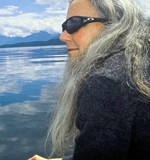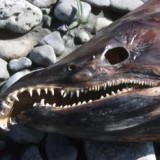The federal agency embroiled in the recent XL Meats tainted beef scandal is at it again – this time leading efforts to cover up a potentially catastrophic farmed salmon flu-like viral outbreak on BC’s coast. Charged with ensuring your food is safe to eat, the Canadian Food Inspection Agency (CFIA) increasingly appears to be acting as a political arm of the Harper Government and an inept custodian of Canadian trade which will do our export business far more harm than good in the long run.
A little over a week ago, it became apparent that the CFIA is working hard to discredit and de-certify one of the two labs in the world recgonized by the World Animal Health Organization (OIE) as experts in detecting a deadly salmon virus, known as ISAv. The lab in question, run out of Atlantic Veterinary College at the University of P.E.I. by Dr. Fred Kibenge, diagnosed the ISAv outbreak that devastated the Chilean aquaculture industry several years ago, causing $2 Billion in damage. Such is his scientific credibility that when the fish farm industry was experiencing unexplained losses of their fish in Chile in 2007, they went to Kibenge to test for ISAv.
Recently, Dr. Kibenge has been testing farmed and wild salmon samples from BC as he investigates a potential similar outbreak here. His findings were instrumental in forcing the re-opening of the Cohen Commission into disappearing sockeye last year, where he went before Justice Cohen as a key witness. That the Commission took Dr. Kibenge’s testimony and research as seriously as it did – reflected in its ultimate findings released a month ago – should be of particular note to the CFIA as they attack his lab and credibility.
During the same judicial proceedings, internal emails revealed these CFIA senior staff acting, as the Commission’s lead lawyer suggested, more like hockey players high-fiving each other after beating their opponent than scientists and civil servants serious about getting to the bottom of a viral mystery which threatens the environment and economy of BC – even the salmon farms themselves.
The emails followed the telephone press conference the CFIA hosted to rebuke the first discovery of ISAv in wild salmon on BC’s coast by independent salmon biologist Alexandra Morton and SFU Professor Rick Routledge. I was on that call and appalled by the lengths they went to dismiss and discredit this groundbreaking new finding. I asked the CFIA’s spokespeople where the Precautionary Principle fit in their approach. Evidently it receives nowhere near the prominence Justice Cohen accords it.
In one of the emails that surfaced at the Cohen Commission, dated November 9, 2011, Joseph Beres, an inspection manager at the CFIA, wrote to colleague Dr. Con Kiley and other senior DFO and CFIA staff who had appeared on the conference call:
Con,
It is clear that we are turning the PR tide to our favour – and this is because of the very successful performance of our spokes[people] at the Tech Briefing yesterday – you, Stephen, Peter and Paul were a terrific team, indeed. Congratulations! One battle is won, now we have to nail the surveillance piece, and we will win the war also.
Cheers, Joe.
In the same strain, Dr. Kiley replies, “Concentrate on the headlines, that’s often all that people read or remember. Both the ‘Top Stories’ and the ‘Related Pieces’.”
During the Commission’s investigation into this matter, Dr. Kibenge addressed what would come to be described by CFIA officials as an “audit” of his lab in the midst of his initial research into ISAv in BC. It is the disputed results of this and one other similar audit that form the basis for the CFIA’s request to the World Animal Health Organization to strip Dr. Kibenge of his status as one of two “reference labs” certified to investigate ISAv outbreaks.
While he was on the stand during the Inquiry, Dr. Kibenge described this bizarre “audit”: “The inspection was meant to be about understanding my processes so they could improve their own practices, but once the inspection began I got the sense that it was about obtaining information, because the first thing they asked me about when they did the inspection was the samples.” Dr. Kibenge added, “I quickly realized that the purpose of the site visit…was actually in my view, to confirm a hypothesis that had already been presented in the media.”
According to Mark Hume, who broke the story last week in the Globe and Mail, “The [CFIA] has promised to sample nearly 8,000 salmon in B.C. in response to concerns about ISA. But the results of those tests are not yet known, and the CFIA has challenged the validity of Dr. Kibenge’s tests, saying government labs couldn’t replicate his results.”
Of course, as the XL Meats scandal taught us, the CFIA’s detection methods are quite capable of failure.
In response to this latest attack on his lab by the CFIA, Dr. Kibenge told Hume, “What they are doing here is essentially punishing me for having testified at the Cohen Commission and trying to suppress the findings that we’ve been finding. It’s an attack on my credibility,” he said. “ I just feel compelled to continue with my research work because there is nothing here that I can see that I’ve done wrong.”
Dr. Kibenge isn’t the only world-class lab working on the BC ISAv mystery. The lab run by Dr. Are Nylund at the University of Bergen in Norway has reviewed some the same samples as Dr. Kibenge and come to similar conclusions about the likelihood of ISAv’s presence in BC waters.
The CFIA has responded to concerns raised about its denial that ISAv is here in BC by affirming its commitment to protecting Canadian trade. If BC were to become officially designated as an ISAv-contaminated region, CFIA employee Dr. Kim Klotins testified at the Cohen Commission, that could indeed close borders to the 92% Norwegian-owned salmon farming industry in BC – a potentially fatal blow to the industry’s local operations. Setting aside for a moment the troubling notion that our food safety inspector views protecting trade as its chief mandate, the CFIA’s defence raises more questions than it answers.
Just as its failure to take proactive enforcement action in the XL Meats scandal ultimately led to a serious blight on Canadian trade – with the temporary closing of the US border to Canadian beef exporters – so will covering up this salmon virus until it has mushroomed into a full-blown catastrophe. This short-term butt covering is downright dangerous – not just to our wild fish, but to the trade the agency purports to be defending.
On the heels of the first indications the virus is already here, CFIA joined senior Harper Government leaders and BC’s Liberal Premier in a coordinated offensive to convince foreign governments there was nothing to these concerns. In November, 2011, Agriculture Minister Don McRae accompanied Premier Clark on a trade mission to China to deliver the message that BC seafood is safe. How will those trading partners feel when they later learn they were misled? What impact will that have on Canada’s international reputation and trading opportunities? There is much more than Norwegian farmed salmon at stake here.
Now, the question that must also be asked, given the agency’s health and safety mandate, is can we be so sure that this salmon virus in the influenza family, from industrial farming practices, won’t mutate in a way that poses a threat to human health such as bird flu and swine flu have done before? I want to be clear: I’m not suggesting there’s a shred of science to support that notion – but the question must be asked, as the science must be done, not stifled at every turn because it’s politically inconvenient.
Justice Cohen called for the Precautionary Principle to be thoroughly implemented in future fisheries management. I suggest the CFIA act accordingly and treat this potential viral outbreak seriously. We may one day be dealing with more than just the loss of our wild salmon and the economy dependent on them.
It is time time for the CFIA to quit playing petty, vindictive political games and to start working with Dr. Kibenge’s lab to get to the bottom of this salmon flu mystery – not to mention to begin regaining the confidence of the public it’s supposed to serve. In all the media they do, the CFIA and politicians rest their criticisms on two admittedly poor initial samples from Rivers Inlet that tested positive for ISAv, which led to many subsequent samples following far more rigourous protocols. To the CFIA, it’s as if the other salmon from BC that have tested positive for ISA virus – including wild fish from various streams and lakes and farm salmon purchased from Vancouver-area supermarkets – simply don’t exist.
While the CFIA appears to think it is acting in the interest of Canadian exports by protecting the salmon farming industry from these damaging revelations, it is in fact undermining our nation’s credibility on the international stage and doing long-term damage to our cross-border trade – all to protect a largely Norwegian-owned industry that contributes marginal economic value to the province of British Columbia.
Prime Minister Stephen Harper must reign in CFIA now and start paying serious attention to this important salmon virus research.








